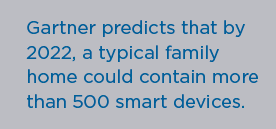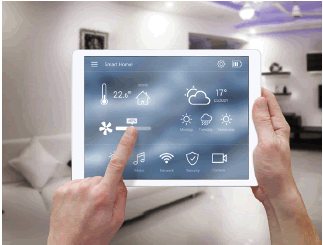Growth of the Connected Home
The connected home is a rapidly emerging market and platform for products and innovations. Whether you call it the connected home, smart home or home automation, it is a hub of activity for connectivity and sensor solutions. While mainstream adoption may still be years away, we know this market is poised for growth. It represents an important opportunity for consumer product manufacturers from devices to appliances, security and lighting, to deliver products that are differentiated with new functionality and connectivity.

As a sensor and connectivity component company, our interest in this market is significant. We proactively identify trends and innovate new product solutions to better serve our customers. Consumer needs are rapidly changing and new features and functionalities are being created that will forever change the idea of value. No one knows what products will be central to the connected home, but we do know you need to place multiple bets. Whether it’s the refrigerator, TV or thermostat, TE Connectivity (TE) will work with our partners to develop product strategies that will enable multiple outcomes.
A Consumer View
Today’s market is fragmented and standards differ. The killer application does not yet exist. Vendors are competing for mindshare with their own version of walled gardens or individual platform standards. What is clear is that there is no one approach or obvious leader today. The migration towards home automation is based on do-it-yourself product solutions versus an integrated home solution. Consumers are confused and the industry is not helping the situation.
The idea of a home hub, long held by the personal computing OEMs to be the future of the home pc, is now very much up for grabs. For now, the primary control device remains the smartphone or tablet. Yet, we see new products entering the market, including digital assistants like Apple’s Siri and Amazon’s Alexa, as well as familiar appliances reappearing with new features enabled by sensing and connectivity. All of these products are competing for a bigger share of mind and control in the home. Samsung is promoting both the smart refrigerator and smart TV as a family hub. The company is using technology from Smart Things, which it bought in 2014, to add home automation technology across their product line. In this example, the two products represent very different strategies and demonstrate both the uncertainty of the primary device, as well as the importance of placing early bets.
We are in a period we call “exploration”. We do not know what the outcome will be from a lead device or must have functionality, but we know that the market is changing rapidly and successful companies are proactively developing and testing new solutions to bring to market.
 Smart connectivity is just a starting point. Connectivity enables the sharing of information and the ability to monitor and control. As artificial intelligence matures and proliferates devices will leverage complicated analysis in the cloud to deliver actionable insights back to users and systems within the connected home. Automation will eventually make routine tasks or chores easier and perhaps invisible. As new value propositions are shaped, we expect to see simplification, increased efficiencies (saving both time and money), and a level of service beyond what can be delivered today.
Smart connectivity is just a starting point. Connectivity enables the sharing of information and the ability to monitor and control. As artificial intelligence matures and proliferates devices will leverage complicated analysis in the cloud to deliver actionable insights back to users and systems within the connected home. Automation will eventually make routine tasks or chores easier and perhaps invisible. As new value propositions are shaped, we expect to see simplification, increased efficiencies (saving both time and money), and a level of service beyond what can be delivered today.
This will drive a virtuous cycle of increased demand for products which can be leveraged to improve data analysis. Understanding behavior and how to drive efficiencies is critical. These improved results will create a better experience for consumers who then demand more products—and the cycle continues.
Adoption and Challenges

Partnerships and touchpoints are critical as service providers, home security companies, retailers, consumer electronics and appliance OEMs bring a range of new hardware and services to market. The rapidly evolving role of mobile devices (tablets, smartphones, wearables) is adding another layer of complexity as management and control preferences are determined and new opportunities are created (such as in the healthcare monitoring space). While complexity continues to increase, the benefit will be unprecedented levels of functionality and service delivery.
Adoption in this space has been slowed down by the challenges around ease of use, installation and control. Add various and competing communication standards, and the proliferation of networking protocols, and you have an ecosystem that is fragmented and competitive. It’s truly ironic that despite increased connectivity, smart devices are not connecting with each other.
Companies are beginning to offer points of collaboration. Samsung has long supported the developer community and specifically supports developers of connected home products via it’s SmartThings platform. Even Apple is recognizing the importance of common technologies. For the first time at their Worldwide Developers Conference they announced two things which may help jump start smart home adoptions. First, they are releasing the Home app for iOS devices that will act as a central control point for HomeKit compatible smart home devices. Second, Apple opened up Siri to third-party developers, just as Amazon opened up its Alexa platform. This will allow app developers to have Siri act as their voice control.
In addition to technology, standards, and security concerns, it’s also important to evaluate the consumer adoption mindset. Early adopters are intrigued by new products and functionalities and start purchasing, testing, and sharing information. Mainstream adoption may be years away, seeing the challenges as roadblocks threatening their desire to purchase. Yet the fact remains that people are testing the waters. Research demonstrates different interest levels and expectations. We see adoption curves differ depending on the product focus, geography and pain points. In some countries, utility companies and government regulations are driving adoption. We think the benefits of automation, remote management and servicing, and other customer friendly features will lead appliance manufacturers to compete to differentiate themselves. They may be the drivers of adoption as OEMs bring products that offer new levels of functionality to the market sooner than later.
Multiple adoption points increase the complexity of the market and companies’ ability to predict when the connected home hits mainstream adoption. We have seen disruptive models and products enter the market completely changing expectations. The smartphone changed expectations around playing music, and the ultrabook changed expectations around the size and weight of notebooks. From a usage model, streaming video changed the idea of entertainment and content delivery. History proves there will be a new entrant that rapidly changes expectations and jump starts adoption.
To read this white paper from TE Connectivity in its entirety, click here.
Nick Langston is the market development leader with TE Connectivity Connected Home.
Recently published:
[related_posts limit=”7″]




